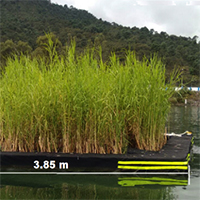Changes in cyanobacterial density due to application of Artificial Floating Island model with macrophytes: an experimental case study in a tropical reservoir

Submitted: 15 January 2020
Accepted: 2 October 2020
Published: 28 October 2020
Accepted: 2 October 2020
Abstract Views: 2357
PDF: 562
Supplementary: 138
HTML: 31
Supplementary: 138
HTML: 31
Publisher's note
All claims expressed in this article are solely those of the authors and do not necessarily represent those of their affiliated organizations, or those of the publisher, the editors and the reviewers. Any product that may be evaluated in this article or claim that may be made by its manufacturer is not guaranteed or endorsed by the publisher.
All claims expressed in this article are solely those of the authors and do not necessarily represent those of their affiliated organizations, or those of the publisher, the editors and the reviewers. Any product that may be evaluated in this article or claim that may be made by its manufacturer is not guaranteed or endorsed by the publisher.
Similar Articles
- Souhaib Hanfouri, Fayçal Ait Boumallassa, Mohamed Naimi, Mohamed Znari, Plasticity of life-history traits in the Draa barbel Luciobarbus lepineyi (Pellegrin, 1939) (Actinopterygii: Cyprinidae) in the sub-Saharan Draa basin, Morocco: effect of change in flow regime and salinity , Journal of Limnology: Vol. 83 (2024)
- Roberto BERTONI, A Surface Bloom Sampler (SUBS) for cyanobacteria and algae , Journal of Limnology: Vol. 70 No. 2 (2011)
- Andrea Di Cesare, Ester Eckert, Gianluca Corno, Co-selection of antibiotic and heavy metal resistance in freshwater bacteria , Journal of Limnology: Vol. 75 No. s2 (2016): Lake Orta: a new lease on life
- Sonja Rigterink, Paula Echeverría-Galindo, Rodrigo Martínez-Abarca, Julieta Massaferro, Philipp Hoelzmann, Bernd Wünnemann, Andreas Laug, Liseth Pérez, Wengang Kang, Nicole Börner, Anja Schwarz, Ping Peng, Junbo Wang, Liping Zhu, Antje Schwalb, Sub-fossil chironomids as indicators of hydrological changes in the shallow and high-altitude lake Shen Co, Tibetan Plateau, over the past two centuries , Journal of Limnology: Vol. 81 (2022)
- Giuseppe Morabito, Phytoplankton assemblages in Lake Orta: has functional structure recovered in one of the largest acidic lakes in the world? , Journal of Limnology: Vol. 75 No. s2 (2016): Lake Orta: a new lease on life
- Claudia Piccini, Daniel Conde, Jakob Pernthaler, Ruben Sommaruga, Photoalteration of macrophyte-derived chromophoric dissolved organic matter induces growth of single bacterial populations in a coastal lagoon , Journal of Limnology: Vol. 72 No. 3 (2013)
- Doris Gesierich, Eugen Rott, Is diatom richness responding to catchment glaciation? A case study from Canadian headwater streams , Journal of Limnology: Vol. 71 No. 1 (2012)
- Irina P. Chubarenko, Elena Esiukova, Natalia Stepanova, Boris Chubarenko, Henning Baudler, Down-slope cascading modulated by day/night variations of solar heating , Journal of Limnology: Vol. 72 No. 2 (2013)
- Jascieli Carla Bortolini, Sueli Train, Luzia Cleide Rodrigues, The variability in the hydrosedimentological regime supports high phytoplankton diversity in floodplain: A 12-year survey of the Upper Paraná River , Journal of Limnology: Vol. 76 No. 3 (2017)
- Karina P. Battes, Laura Momeu, Diel vertical distribution of planktonic microcrustaceans (Crustacea: Cladocera, Copepoda) in a natural shallow lake from Transylvania, Romania , Journal of Limnology: Vol. 73 No. 2 (2014)
<< < 14 15 16 17 18 19 20 21 22 23 > >>
You may also start an advanced similarity search for this article.

 https://doi.org/10.4081/jlimnol.2020.1959
https://doi.org/10.4081/jlimnol.2020.1959






